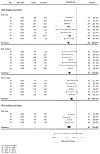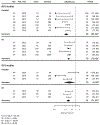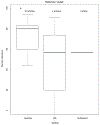A decade of experience with rotavirus vaccination in the United States - vaccine uptake, effectiveness, and impact
- PMID: 29909693
- PMCID: PMC9199965
- DOI: 10.1080/14760584.2018.1489724
A decade of experience with rotavirus vaccination in the United States - vaccine uptake, effectiveness, and impact
Abstract
Introduction: Prior to 2006, nearly every U.S. child was infected with rotavirus by 5 years of age, and rotavirus was the leading cause of severe childhood gastroenteritis. In February 2006 and June 2008, the Advisory Committee on Immunization Practices recommended a live attenuated pentavalent rotavirus vaccine (RV5) and a monovalent rotavirus vaccine (RV1), respectively, for routine vaccination of infants in the United States.
Areas covered: We reviewed U.S. data on coverage, vaccine effectiveness (VE), and vaccine impact from 2006 to 2017. National rotavirus vaccine coverage estimates increased since vaccine introduction but plateaued at 71-75% in 2013-2015, a level 15-20% lower than that of other routine childhood vaccines. Pooled VE of full series RV5 and RV1 against rotavirus-associated hospitalizations and emergency department visits were 84% (95% CI: 80-87%) and 83% (95% CI: 72-89%), respectively. Vaccine introduction resulted in a median decline in rotavirus-associated hospitalizations and emergency department visits of 80% and 57%, respectively, along with indirect protection of unvaccinated age groups and a decrease in health-care costs. A biennial pattern in rotavirus detection emerged post-vaccine implementation.
Expert commentary: The increasing use of rotavirus vaccines has substantially diminished the burden and changed the epidemiology of rotavirus disease in U.S. children; efforts to increase rotavirus vaccine coverage should continue.
Keywords: RotaTeq; Rotarix; Rotavirus; gastroenteritis; vaccination program; vaccine.
Conflict of interest statement
Declaration of interest
The authors have no relevant affiliations or financial involvement with any organization or entity with a financial interest in or financial conflict with the subject matter or materials discussed in the manuscript. This includes employment, consultancies, honoraria, stock ownership or options, expert testimony, grants or patents received or pending, or royalties.
Figures






References
-
- Glass RI, Kilgore PE, Holman RC, et al. The epidemiology of rotavirus diarrhea in the United States: surveillance and estimates of disease burden. J Infect Dis. 1996;174(Suppl 1):S5–11. - PubMed
-
- Jin S, Kilgore PE, Holman RC, et al. Trends in hospitalizations for diarrhea in United States children from 1979 through 1992: estimates of the morbidity associated with rotavirus. Pediatr Infect Dis J. 1996;15(5):397–404. - PubMed
-
- Kilgore PE, Holman RC, Clarke MJ, et al. Trends of diarrheal disease-associated mortality in US children, 1968 through 1991. Jama. 1995;274(14):1143–1148. - PubMed
-
- Charles MD, Holman RC, Curns AT, et al. Hospitalizations associated with rotavirus gastroenteritis in the United States, 1993–2002. Pediatr Infect Dis J. 2006;25(6):489–493. - PubMed
-
- Esposito DH, Holman RC, Haberling DL, et al. Baseline estimates of diarrhea-associated mortality among United States children before rotavirus vaccine introduction. Pediatr Infect Dis J. 2011;30(11):942–947. - PubMed
Publication types
MeSH terms
Substances
Grants and funding
LinkOut - more resources
Full Text Sources
Other Literature Sources
Medical
